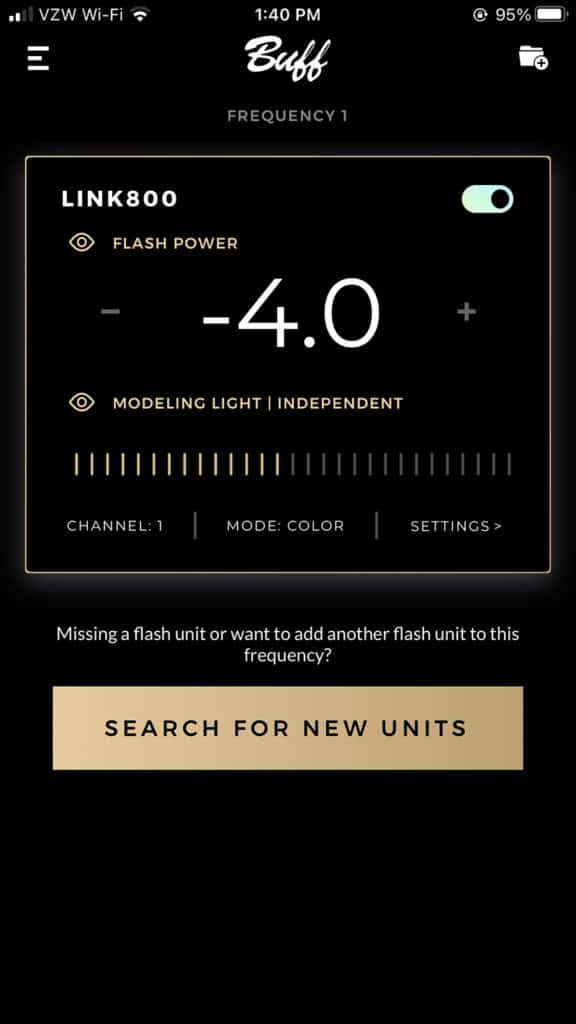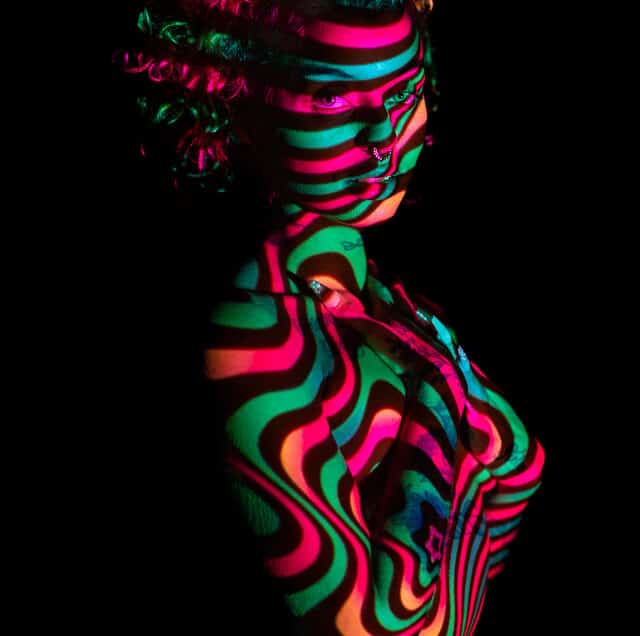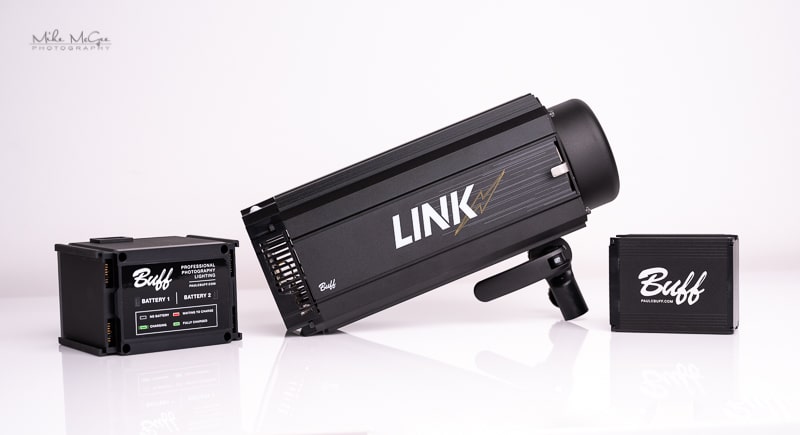
Paul C. Buff Link flash unit with optional battery charger and battery.
PAUL C. BUFF LINK FLASH UNIT / STROBE REVIEW
It’s here. It’s finally here. Originally scheduled for release in 2020 (and delayed due to COVID-19) the Paul C. Buff Link Flash was released on February 23, 2021. If you’re a fan of Paul C. Buff products, you probably already know that this is a big deal. And if you’re like me, you’ve probably been waiting years to have the ability to shoot High Speed Sync (HSS) with a Paul C. Buff strobe. In the past, maybe you read online some workarounds on getting HSS to work with an Einstein strobe, but they never actually worked and you gave up. Sound familiar? Well, today is your day. The all-new PCB Link Flash unit has finally been released, I bought one, and I’ve run it through its paces and here’s Link flash review.
RIGHT OFF THE BAT
This will be my completely unbiased review of the Paul C. Buff Link. I purchased this flash with my own money, and was not paid in any way by Paul C. Buff, Inc. and there are no affiliate links in this Link flash review.
VIDEO REVIEW
If you hate reading a wall-o-text like this one, and would rather view a video review on YouTube, here is a link to my video review of the new Paul C. Buff Link flash/strobe:
https://www.youtube.com/watch?v=In7blgq_8SE
MAIN PRODUCT DETAILS AND SPECS
- Adjustable in precise 1/10 f-stops
- All-digital control from LCD display
- Built-in CyberSync Transceiver
Compatible with CST2, CyberCommander and CyberSense remotes* - Global plug-and-play from 100 to 240 VAC
- Available Modes: ACTION, COLOR, HSS (up to 1/8000 sec.), TTL
- Action stopping flash durations as short as 1/18,600 sec. (t.1)
- Color consistency +/- 50K at any power
- Bright, adjustable 800W Equivalent Daylight-Balanced LED Modeling Lamp
- Rubber diffusion dome cover
- Audible and visual recycle indicators
- Built-in battery connection
- Comes with a Two-Year Factory Warranty (see more below)
Price (Flash Unit Only): $895.95 (link)
BUNDLE PRICE:
- (1) LINK 800WS Flash Unit
- (1) LINK Charger
- (1) LINK Battery
- (1) HUB remote (Canon or Nikon)
Price (Bundle): $1,199.95 (Nikon link or Canon link)
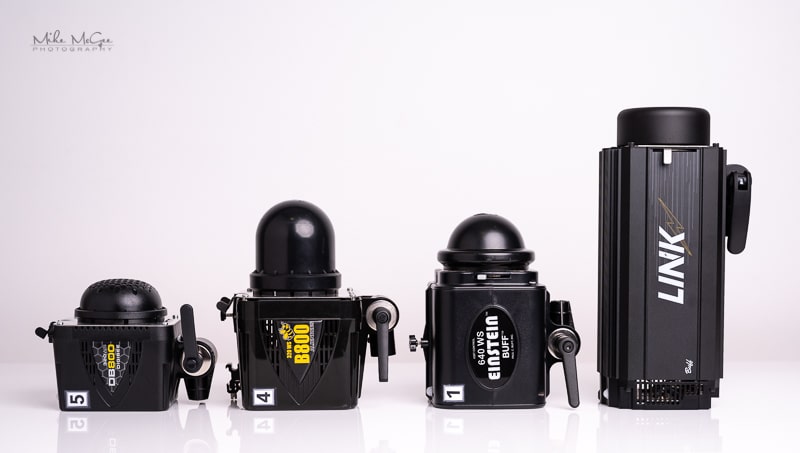
Paul C. Buff Link flash unit with size comparison in relation to some of my other Paul C. Buff strobes like the Einstein e640, AlienBee B800, and DigiBee DB800.
BRIEF HISTORY
If you’re new to Paul C. Buff products, you might be wondering what the big deal is. Well, this company is revolutionary in that they built a reputation on producing high quality products sold direct-to-the-consumer, with excellent customer service at a solid price point. Paul C. Buff strobes like the AlienBee and Einstein have been around for years, routinely perform time and time again, and can take a beating. They’re at a fair price, they work, and they last. In fact, Paul C. Buff light modifiers are so well built that many people with strobes from other brands still buy them and then convert the Balcar mount to a Bowens mount to use with non-Buff strobes they already own. That says something. Also, If you ever have an issue with your Paul C. Buff products, even when they are years out of the warranty period, you can send them back to Paul C. Buff’s headquarters in Tennessee and they will repair or replace your item(s) all for a reasonable cost (sometimes for as little as around $35.) This customer service-oriented approach has allowed them to build a strong following over the years, and that’s why people like me are loyal to their products. So you can see why the release of the Link strobe was such a big deal and eagerly anticipated.
THE MISSING ‘LINK’
I’m guessing the name “Link” for this product is based on this strobe being the connecting bridge or “Link” between the Paul C. Buff products of old, and new more-advanced Paul C. Buff strobes we might see down the road that offer built-in CyberSync/smartphone app integration, battery pack add-ons, TTL, and High Speed Sync. Only time will tell.
FIRST IMPRESSIONS
When unboxing the Link for the first time, one thing is striking…it’s heavy. I mean really heavy by comparison to a DigiBee, AlienBee, or even an Einstein. Where the DigiBee went in a smaller/lighter direction from its previous counter-parts, this strobe goes in the opposite direction. To put things into perspective, here are the dimensions and specs for the following Paul C. Buff Strobes:
- DigiBee B800: (Length: 5.25” x Height: 7.25” x Width: 4.75”) 2.9 lbs.
- AlienBee B800: (Length: 8.5” x Height: 7.87” x Width: 5.75”) 2.9 lbs.
- Einstein: (Length: 7.8” x Height: 7” x Width: 5.4”) 4 lbs. 5 oz
- Link: (Length: 12.6” x Height: 6.5” x Width: 4.8”) 7 lbs 8 oz. (without battery) or 8 lbs. 11 oz (with battery)
Have I mentioned it’s heavy? If you’re accustomed to using any of the other Paul C. Buff strobes above, you’ll notice that with a battery, the Link is over double the weight of the Einstein, and three times the weight of an AlienBee or Digibee. This is largely due to the expanded design, as well that the housing being made from aluminum and not plastic. That weight is a serious concern for me, especially when mounting it on a boom over a model/client for beauty headshots and such. Be warned that you will want to ensure you have an extremely strong boom arm (with a counter-weight) to avoid any dangerous situations when mounting this overhead. Expect a bend in your boom arm when expanded to the maximum length. Be careful, folks.
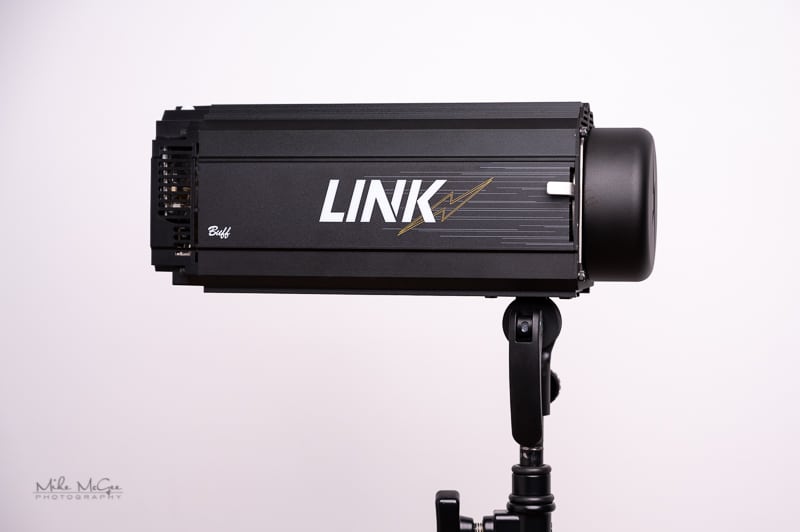
Paul C. Buff Link flash unit side view with all-aluminum shipping cover attached.
LINK DESIGN:
As photographers, we perform a technical art. The nerd in me loves the specs of the Link so much that the artist in me is willing to give the design a bit of a pass. I just consider this design a bit “retro” like the Cybertruck. It’s not smooth or sleek like Profoto or even Godox strobes, and instead the Link has hard lines and multiple ridges. It’s not sexy, but then again, does it really need to be? The sides of each Link flash have plastic plates that “pop-in” with the Link and Buff branding. They aren’t made to be easily user-swappable, but one idea that could possibly transform the design of the Link would be to allow for customization of the two plastic cover plates on each side. Not sure if this idea would ever make financial sense, or if Paul C. Buff (or a third party company) ever wanted to go into the custom printing business, but it would be great if someone offered a service to allow photographers the ability to upload a vector version of their own logo, and then order custom-branded identical plastic plates to pop into the side of each Link strobe. Professional custom branded gear to take advantage of the name plating on the side? Sign me up if someone creates a kickstarter for this. Just an idea.
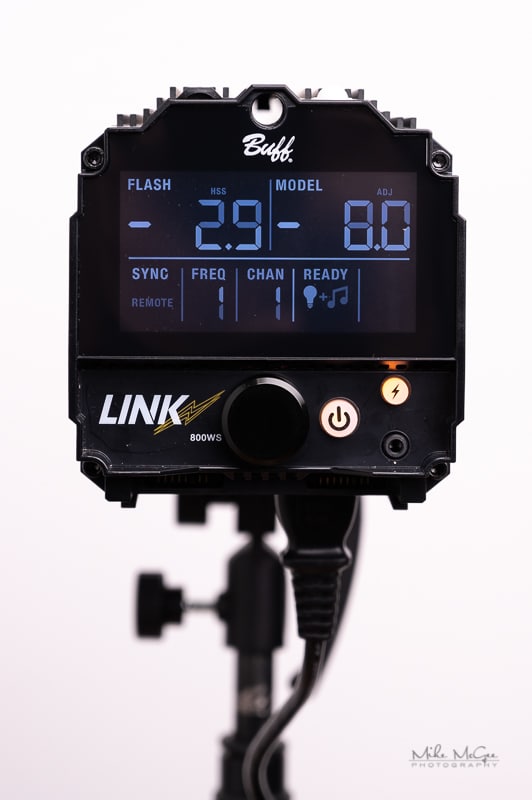
Paul C. Buff Link flash unit back panel view while running on AC power.
LINK BACK PANEL CONTROLS:
Well, I might as well knock out many of the negatives of this flash unit right out of the gate. With the strobe being so heavy, I already thought I had possibly made a mistake in buying this unit…and then I turned it on. Argh. The controls on the back, aren’t as convenient or intuitive as my other Paul C. Buff strobes, and everything is managed on the back with one main rotary dial/button. The same button holds multiple functions, and you push in and hold it to make selections, as well as turn it clockwise/counter-clockwise to change selections, change strobe power, etc. I’m personally coming from a perspective of using Einsteins for many years, and on the Einstein, the dedicated Function button and separate up/down arrow buttons make for a far easier user experience when making adjustments. On the Link, the rotary dial requires the user to push a button and wait (two seconds?) to get into an adjustment screen that just slows down the process, and spinning the dial again and again and again to reduce power takes far longer than simply pushing and holding the down arrow on the Einstein for quick power changes. I will likely get used to this rotary dial of the link, and maybe it’s just me, but it’s not a design that comes naturally to me.
PCB HIGH SPEED SYNC IS HERE. IT’S REAL, AND IT’S SPECTACULAR.
If you’re new to using High Speed Sync (HSS) and don’t really know what it is, here’s a brief explanation: High Speed Sync allows you to use your flash at a shutter speed that goes above and beyond the maximum 1/200 of a second which is a normal flash sync speed on your camera. Why is this important? Well, let’s say you’re shooting an outdoor portrait on a sunny day, and you’d like to use a wider aperture (like f/1.8) for some creamy background bokeh/blur, but you don’t want the background to be overexposed. If you want that shallow depth of field, that means you must open up the aperture (f/1.8 for example) but by doing so, you’re letting too much light in for a proper exposure. At this stage you basically have two options: 1. Use ND filters that are similar to tinted car windows to reduce the amount of light that reaches the sensor, or 2. Use a higher shutter speed beyond 1/200 of a second to reduce the amount of light into the sensor. However, you can’t set a shutter speed higher than 1/200 of a second if your strobe cannot perform High Speed Sync. If you do, you’ll actually catch part of the shutter closure in your shot, resulting in a black “bar” on some or all of your image depending upon the shutter speed. So this is why a High Speed Sync capable strobe it so important. It allows for full flexibility over shutter speed adjustments all the way beyond your camera’s max shutter sync speed. In the case of the Link, you can now set your shutter speed all the way up to 1/8000 of a second, and the strobe with adjust the light output/duration of the flash accordingly, and this, my friends, is high speed sync. As I mentioned in the opening, I have tried multiple ways and workarounds in the past to get something even remotely similar to High Speed Sync to work on Einsteins, but nothing ever worked. Now, with the Link, it’s baked right in. To say that I’m happy about this is an understatement. It should also be noted that TTL (which automatically adjusts light output based for a balanced/metered exposure) is also coming soon via a firmware update. (It is currently unavailable at the time of this writing). So whether High Speed Sync, TTL, and other benefits of the Link are going to be worth the price bump up from an Einstein for example, is really up to you, but for me, it’s a no-brainer as I’ve been waiting years for the flexibility of High Speed Sync alone.
LINK HUB REMOTE + SMARTPHONE APP CONTROLS…FANTASTIC!:
As much as a dislike the new rotary dial on the back of the Link, this is after all an entirely new product, with new features, and requires a new way of thinking. And that brings me to the new HUB Remote that works with the companion smartphone app. If you purchased the Link in order to shoot with High Speed Sync, then you need to purchase the Hub remote for your camera (only available for Nikon or Canon, and at the time of this writing the Canon version is still in development.) So paired with a HUB remote, the Link can now be accessed via the all-new Buff smartphone app. The app is so good that it might make the controls on the back of the unit essentially obsolete anyway, and it completely changed my way of thinking about this unit. The Buff smartphone app is free and allows for full control each Link flash unit, (and all other Paull C. Buff Strobes) right from your smartphone. Just launch the Buff app, and after an initial pairing, you will now see your Link strobe from the app’s menu. Just tap on your Link, and you have full control over the unit, and the ability to change any setting with ease. But it doesn’t just work with your Link strobe. The app can also connect and control all of your other Paul C. Buff strobes like the Einstein, DigiBee, AlienBees and White Lightning flash units, provided you have the compatible CyberSync receivers for each unit. This is really impressive. Think of the app as a touch-screen for the back of the unit (if it had one), or for an updated CyberCommander with a more intuitive user interface. You can slide up/down the power of the modeling lamp with a swipe of the finger, and so on. It’s perfect, and completely removes my apprehension toward the back of the unit controls. Any gripes I had with the buttons on the back of the unit were quickly dashed after using this fantastic app. The Buff app is free, and available for both iOS on the App Store and for Android on Google Play.
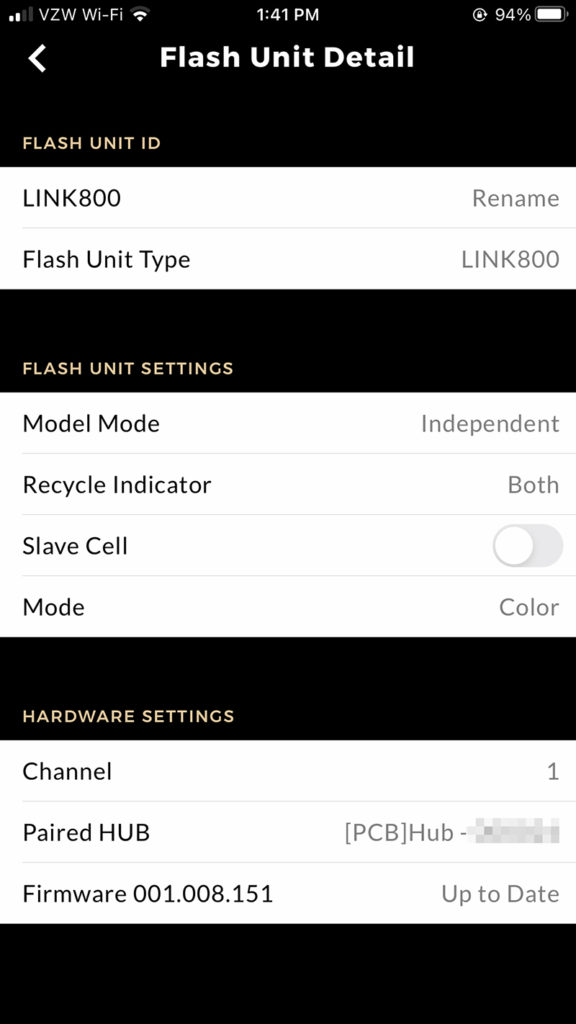
THE APP + HUB REMOTE IS SO IMPRESSIVE I SWITCHED FROM POCKETWIZARDS
The Buff app + the HUB Remote is really is a game-changer to me. I’m sure there are fans of the Paul C. Buff CyberCommander but it never was intuitive for me. It was tough to see when using outdoors in daylight, and the menu system just didn’t with the way my brain works. So after trying the CyberCommander nearly a decade ago, I bailed on it and just went to using a PocketWizard system. That meant I purchased PocketWizard MC2s for all of my Einsteins, and for AlienBees or Digibees, I would just use a sync cord and a simple Pocketwizard receiver to make it pop. This system is (was) reliable and great, but it’s not a smart system and it meant I sometimes had to climb up on step ladders to make slight adjustments on the back of each strobe on a boom arm. Well, with the new HUB Remote + Buff app combo, being able to replace the CyberCommander interface with the Buff app is an entirely new ball game. Everything makes sense to me and is completely intuitive to how my brain works. It works so well that the introduction of the new HUB Remote has made me now just switch back to the Paul C. Buff CyberSync triggering system completely for all strobes. So for my Einsteins, I swapped out my PocketWizard MC2s for CyberSync CSXCVs, and now I just plug CSXCVs into my Einsteins (or DigiBees) and manage them all, including the Link, thanks to the Buff app. This is a seriously impressive strobe management system with the new Buff app.
DO YOU NEED A CSXCV RECEIVER TO USE THE LINK?
No. Although the Link does have a port on top, the Link flash unit includes a built-in receiver, so you don’t need to purchase one for it. If you’re wondering why then they would include a port on top, this is an optional choice to increase range of the triggering system if need be with a CSXCV inserted. Not required.
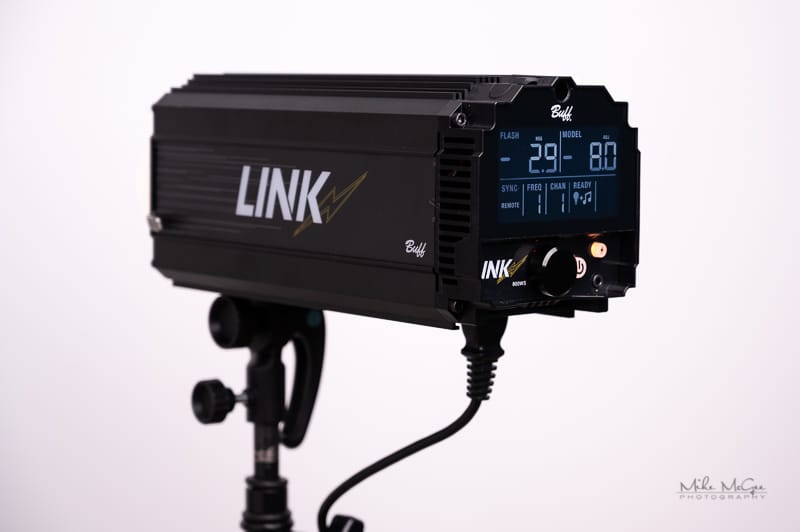
Paul C. Buff Link flash unit side view running on AC power.
FOR HIGH SPEED SYNC, CAN YOU USE A THIRD PARTY TRIGGERING SYSTEM LIKE THE POCKETWIZARD FLEXTT5 AND MINI TT1 COMBO?
I actually don’t have a definitive answer to this, and it’s a shame. I have all of the gear, and want to test it, but the issue is mainly due to PocketWizard’s system of requiring payment for firmware updates for each of their triggers/receivers. No thanks. When I connected the PocketWizard FlexTT5 via a sync cord to the Link along with a MiniTT1 connected to my Nikon D750, it technically fired at 1/8000 of a second at f/1.4, but there were serious banding issues that made the images unusable. So I wanted to try with my new camera body, my Nikon Z6ii, but that camera body is too new to even work with the PocketWizard MiniTT1, even if I wanted to pay PocketWizard to update the firmware. The latest paid firmware update for the MiniTT1 is compatible with the Nikon Z6 and Z7, just not the Z6ii and Z7ii…yet? Ever? So that was a dead end for me. So rather than playing the game of paying for PocketWizard firmware updates for both the transmitter and receiver, and then crossing my fingers again and hoping it worked, I just dumped PocketWizards and moved to the Paul C. Buff CyberSync system for my strobes. The HUB Remote and the Link work perfectly with High Speed Sync, even with the latest Nikon camera body like the Z6ii. I don’t want to be tied to a defacto subscription model with PocketWizard every time I need to update the firmware on each PocketWizard triggers/receivers, so PCB CyberSync it is from now on.
THE HUB REMOTE EVEN WORKS WITH MODERN MIRRORLESS CAMERAS
I’m shooting with a new Nikon Z6ii. As noted, my PocketWizard Mini TT1 isn’t even supported at all (as of the time of this writing) so I couldn’t use the Mini TT1 triggering system even if I wanted, thankfully the new HUB Remote works like a charm.
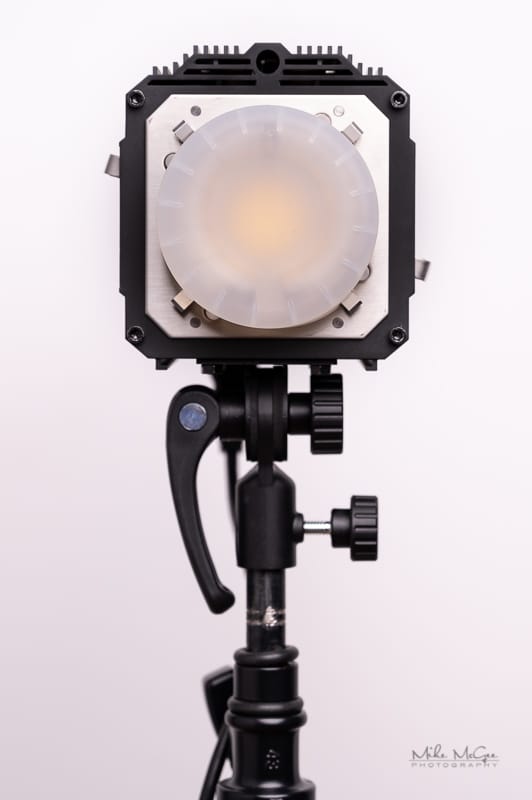
Paul C. Buff Link flash unit front view with the Balcar mount and new silicon diffusion dome.
THE BALCAR MOUNT
The Link flash unit uses the Paul C. Buff Balcar mount that they have had for years. This is great news for those of us who have invested quite a bit of money into the many Paul C. Buff light modifiers over the years that are high quality and long lasting. But this is a bit of a double-edged sword. The Balcar mount isn’t as secure to me as let’s say the Bowens mount. So there are pros and cons with this approach. This could have been an opportunity to completely change their mounting system going forward for added grip strength and compatibility with other modifiers, but that would mean abandoning compatibility with all previous light modifiers. So Paul C. Buff split things down the middle and kept the Balcar mount but advertised that the Link has an updated gripping mechanism with stronger teeth for added grip strength. To me, the dials on the side are strong and will work fine when connected to various light modifiers I have. However, the opening/closing levers don’t move quite a smoothly and feel “gritty” for lack of a better word. Even grip the all-new aluminum cover/cap fits somewhat oddly and not always on the first try. Maybe that’s just my unit, but it takes a bit of fidgeting to get the cover to lock onto the strobe and have the side lever in the full back position. This is a minor gripe, and being that I didn’t experience any problems when actually using it with a light modifier like a softbox or beauty dish, it’s a non-issue but still worth noting.
THE UMBRELLA CHANNEL
Sometimes you can overthink things. I’ve never ever had an issue with the umbrella channel. The design of previous Paul C. Buff strobes always just had a smooth and clear umbrella channel tube, with a tightening screw on top to lock it in place. Simple, effective, trouble-free. The new Link strobe changes this. It now has no screw on top, but instead uses three internal retention clips to secure the umbrella rod. This allows for a sleeker design (without the need for a tightening screw on top) but to me, form follows function. All of this sounds good until I tried using it for the first time. The first time I used it, I used it with my Beauty Dish. After inserting the Beauty Dish rod into the channel, it just stopped into the channel, and didn’t stay. Either I had a seriously stuff “retention clip” that didn’t want to budge and retain anything, or it was faulty. And since it’s is a brand new strobe so I didn’t just want to force it in. I eventually got it secured not by pushing harder, but by spinning the rod clockwise as I inserted it in. It eventually stayed in place. Again, perhaps this is just a quirk of having a brand new unit, and it will eventually soften up over time, but hopefully this doesn’t become an issue down the road. I would hate to eventually have to send back a strobe and wait two weeks for repair and return shipping for something that could be solved if they just used the old basic tightening screw system. We’ll see.
THE NEW SILICON DIFFUSION DOMES
I need to really come up with another phrase besides “game changer” but this is a wonderful addition to the Link as well. The Einstein uses a glass dome to protect and diffuse the light from the flash tube, and the Alien Bees just go commando. The Link, however, has an extremely creative diffusion dome made from silicon/rubber. It’s a diffused silicon dome/cover that attaches via four strong magnets at each corner. Why is this so impressive? Well, Paul C. Buff now has optional colored diffusion domes that you can quickly and easily remove to apply as colored gels, or to color correct. These optional colored gel domes don’t interfere with the mounting of light modifiers, so that means you can now easily use them in conjunction with all of your light modifiers like soft boxes and strip boxes both with and without grids. If you’re like me and use colored gels often, these heat-resistant colored domes won’t melt and are a really exciting option to have with the new Link.
MODELING LAMP IS GREAT FOR VIDEO OR WITH COLORED GELS
If you use colored gels often and use them close to the flash bulb with an AlienBee or Einstein, you may still have that smell of burned film gels in your mind with the modeling lamp has run too hot. “What’s that smell? Oh $*&^%!!!” when the heat of the modeling lamp cooks and melts colored gels. I’ve been there, and maybe you have too. Well, with the DigiBees, Paul C. Buff Inc, solved this by adding an LED modeling lamp to Buff strobes for the first time. The DigiBees have an LED modeling lamp that is 400W equivalent and daylight-balanced. For the new Link flash unit, Paul C. Buff has also included an LED modeling lamp, and this time it’s rated as 800W equivalent daylight-balanced rated at 12,000 lumens. That’s double the already impressive brightness of the Digibee modeling lamp. For flash photography this is a nice addition, if you’re doing colored gel work with a continuous light and dragging the shutter, for example, but for videographers or content creators, this means the new Link flash unit doubles as a continuous lamp for video as well. Now I can use all of my existing Paul C. Buff light modifiers with a native Buff strobe that has a continuous lamp suitable for video. Another excellent addition.
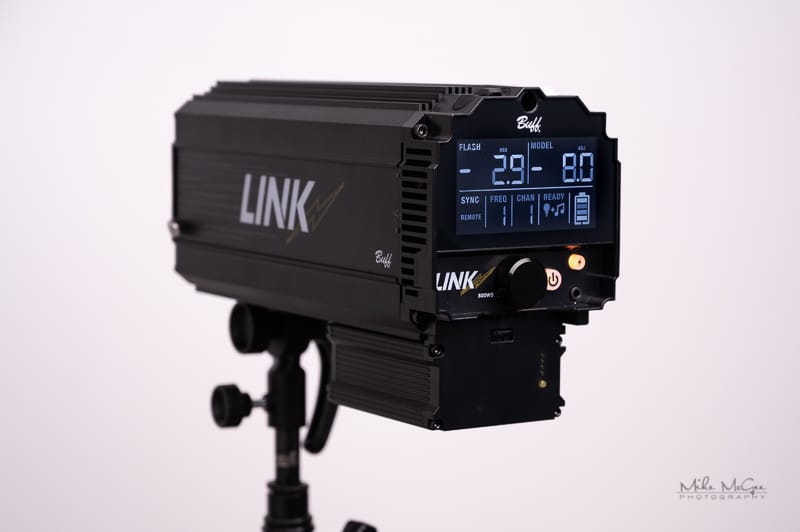
Paul C. Buff Link flash unit side view with optional battery attached running on battery power.
BATTERY POWER (OPTIONAL) THAT CLICKS RIGHT IN
Major feature alert. If you’re a fan of Buff gear, you probably have a few AlienBees or Einsteins, and then you also purchased the Vagabond Mini to have portable power when on-location. This was the go-to method for many of us for years. Well, with the Link, you can now just click in a battery pack at the bottom of the unit and you have power on-the-go. Paul C. Buff advertises that a single battery will allow for up to 250 pops at full power, but since this strobe can overpower the sun, you’ll likely to get an entire shoot’s worth of shots on one battery since you probably won’t be shooting at full power with every click. If you do run out of juice, you can just buy another battery, and the charger and charge two batteries simultaneously. Oh, and if you thought the Link was heavy before, it’s even heavier with the battery attached. Yikes.
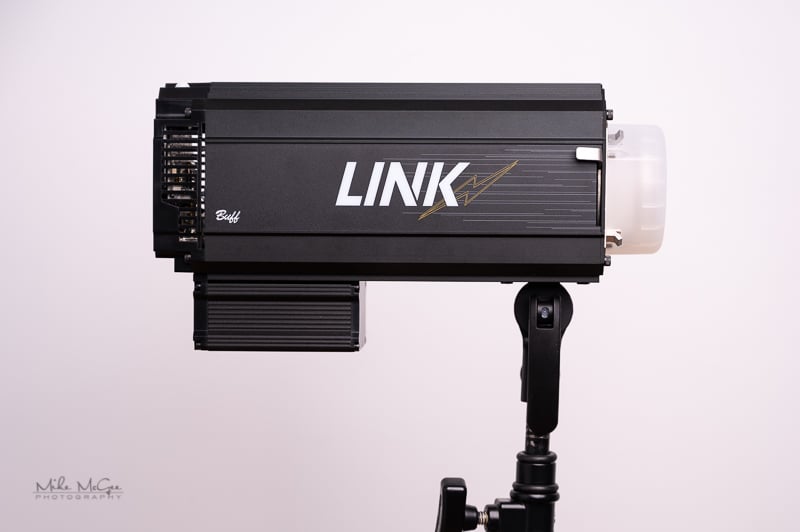
Paul C. Buff Link flash unit side view with shipping cover removed and optional battery attached.
BATTERY WARRANTY – HEADS UP
Paul C. Buff has always had a fantastic warranty when purchasing their products. “Everything you purchase arrives with a 60-Day Absolute Satisfaction Guarantee, giving you 60 days to try out the equipment and make sure that you love it.” This warranty is excellent and really gives you an opportunity to ensure the products are right for you. However, it’s worth noting that as of 3/26/21, all batteries are no longer eligible for their 60-Day Satisfaction Guarantee. If you get a defective battery right out of the gate, then yes, Paul C. Buff will replace it since it’s defective. But if you’re simply not satisfied with the Link and you purchased the battery kit or an optional battery, you will receive a full refund, but not for the battery. Thought this was worth a mention.
LINK SHUT OFF FAN
Another odd little quirk to mention is the shut off fan on the Link. When you use the Link flash unit with AC power, and power it off, the fan will continue to run for about a minute or two even when the unit is powered off. I can understand if the strobe has been firing away for hours and needs to cool down, however, for my unit, the fan will remain on, even if you only powered on the strobe for 1 second, and even if you’ve never even fired a shot. Perhaps this will be fixed in a future firmware update and make it temperature-based, but for the time being, it’s a bit odd to turn off the Link and see the back panel go completely dark, but still have the fan running. When turning off strobes, that typically means the shoot is over and that’s when I want to break down the set and go. So I called in to Paul C. Buff tech support and asked if we can unplug it when it’s off and the fan is still running. The PCB tech said “Good question, let me look it up. Well, as long as you don’t put it in a closed case right away, it should be fine to unplug it with the fan running.” Hmmm…I think I’ll just wait to be safe, and keep my fingers crossed for a firmware update that may address this.
SO WHAT ABOUT GODOX/FLASHPOINT AS AN OPTION?
Due to the delay from Paul C. Buff, Inc to get this type of High Speed Sync capable strobe to market, other manufacturers have stepped up and become serious players at this price point. While Profoto is at a more premium price point, probably the main competition that has flourished in the PCB void has been from Godox / Flashpoint. While these are certainly options, I’m sticking with Paul C. Buff. I actually owned two Flashpoint (rebranded Godox) strobes, and used them in conjunction with the previously mentioned PocketWizard Mini TT1 and FlexTT5 to achieve High Speed Sync. They were battery operated and it worked. Easy High speed sync in a strobe that has more power than a speed light. It was another tool in the arsenal, and from that perspective, I was happy. Even now, Godox / Flashpoints has comparable strobes that are less expensive than the Link, but that doesn’t always tell the whole story. If you have an issue with your Godox strobe, or have a broken part, their customer service is extremely lacking to say the least. At the time of owning my Flashpoint strobe, I don’t believe Godox/Flashpoint had any system in place to actually repair anything. They could replace strobes, but not repair them. That’s something to seriously keep in mind down the road. With Paul C. Buff gear, the customer service is amazing. You can call up and speak to an actual person, and even without speaking to someone you can fill out a form and send a decades old strobe back for repair, at a fraction of a cost of replacing items.
I personally also found that with the Flashpoint/Godox strobes I owned, color consistency over the full power range of the strobe was really inconsistent. So for me, it wasn’t just the specs, it was planning for the long haul, and the long-term use of the products. Heck, I still have some AlienBees that are 15+ years old, and they’re still going strong. But even if they have a crack in the casing, or break, I like the ability to get it repaired in the USA, and then be back up and running without having to treat strobes as being disposable if they are out of warranty. I can completely understand if some people have a different view, or shoot less frequently to where the Link may be cost-prohibitive over other products, but for me, I like to keep my gear going strong for years and years and would rather pay a tad more upfront with the peace of mind in knowing that I can have anything repaired down the road. Just my take.
PROS:
• High Speed Sync!! (Up to 1/8000)
• TTL (Coming Soon as of this writing)
• 800W power
• Diffusion domes are silicon and magnetic. Great for optional colored gels.
• HUB Remote works like a charm for High Speed Sync (even with new Nikon Z Cameras)
• Buff app is FANTASTIC!!
• Optional Battery power built-in (no more Vagabond Mini II)
• Long term reliability and customer service
• Modeling light power makes it suitable for video (continuous)
CONS:
• It’s heavy. Requires a strong heavy-duty boom arm and counter-weight
• Balcar grip mechanism still doesn’t grip as well as Bowens mount
• No current or planned support for Sony or Fuji
• Back main circular dial is slow (Becomes a non-issue when using the app)
• Design? Love it or hate it.
• Odd “click” sound when the strobe fires.
• Fan continues to run for 1-2 mins when switched off.
• Internal retention clips take getting used to.
• Shipping costs, delay, and International buyers
• 2-Year Factory Warranty but NOT on batteries
CONCLUSION:
I have to be honest, within the first five minutes of pulling the Link flash unit out of the box, I thought I was going to box it pack up and return it. Feeling the weight, seeing the design up-close, and using the back dial, were all initial negatives for me. Frankly, they still are. However, those negatives are only one way to interact with the device, and after running it through its paces, this item not only grew on me, it did so quickly. After testing out some of the key features (high speed sync, HUB Remote, the Buff smartphone app, silicone domes, built-in battery, etc.) it all just works, and works extremely well. I’m such a huge fan of my Einsteins, that I won’t be ditching them to replace them with Link strobes, but rather the Link will be used to compliment them. My Einstein strobes are still perfect for manually-powered in-studio shooting that doesn’t require me to use High Speed Sync or TTL. But the Link is now an added tool that allows for mobility by shooting basically anywhere via simple battery power, along with HSS/TTL (soon), and I can continue to use all of my high quality Paul C. Buff soft boxes and light modifiers. It might be interesting if the next strobe from Paul C. Buff is simply a revamped Einstein v2.0 that is made for in-studio AC power but can shoot High Speed Sync. But for now, the Link is the type of strobe I was clamoring for nearly a decade ago, and with the addition of the Hub Remote and Buff smartphone app, the Link and Paul C. Buff triggering system even made me switch from PocketWizards as well. Yes, it’s that good.
HAVE A QUESTION OR COMMENT ABOUT THIS REVIEW? PLEASE USE THE COMMENT SECTION BELOW
Have a question or comment about this review? Please use the comment section below, and I will do my best to answer any questions, thanks.
Want to learn more about a photoshoot or have a question?
Interested in a photoshoot? Just use the contact page here to email me with any photo session ideas you may have. If you are interested in portraits or headshots, and looking for a San Francisco headshot photographer, I shoot professional portraits and professional headshots both outdoors with natural light and/or strobes, or in my San Francisco Bay Area-based photo studio with a wide variety of backdrops and lighting options for many types of projects. Whether you need fashion photography, portrait photography, yoga or fitness photography, headshot photography, an online dating profile photographer, beauty headshot photography, artistic extreme colored gel hypercolor portraits, product photography, modeling digitals for agencies, or anything in-between, I offer various packages for many budgets. I look forward to hearing from you. Let’s shoot!


